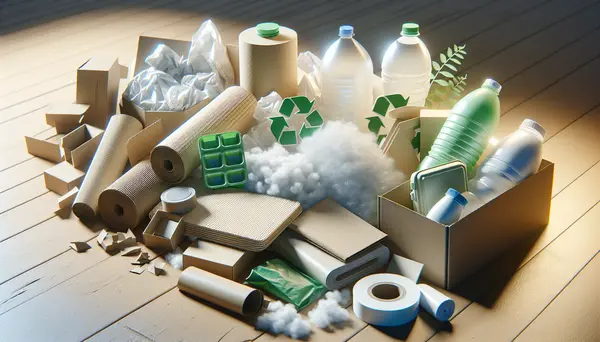Table of Contents:
Introduction
As environmental concerns continue to gain prominence in public and corporate consciousness, the topic of sustainability in packaging design has emerged as a crucial issue. Packaging, often viewed as a necessary evil, has come under scrutiny due to its environmental impact and the waste it generates. But packaging doesn't need to be the villain. If appropriately designed, it can play an essential role in reducing environmental harm. Sustainability in packaging design can provide a solution that both meets the practical needs of consumers and businesses while also reducing environmental impact.
Understanding Sustainability in Packaging Design
Sustainability in packaging design refers to the application of environmentally-friendly practices and materials throughout the design and manufacturing process of packaging. This involves using materials that are recyclable or biodegradable, reducing the overall use of materials, and designing packaging in ways that facilitate recycling or reuse.
Designers focus on the life-cycle assessment (LCA) of a package - from sourcing raw materials, through the manufacturing process, distribution, use, and ultimately the package’s end of life. The idea is to minimize the environmental footprint at every stage of this cycle.
Pros and Cons of Sustainable Packaging Design
| Pros | Cons |
|---|---|
| Reduction in Carbon Footprint | Higher Initial Cost |
| Improves Brand Image | Delicate and Less Durable |
| Waste Reduction | Design Constraints |
| Potential for Recycling and Reusing | Complex Governmental Regulations |
| Drives Innovation | Limited Supplier Options |
The Three R's: Reduce, Reuse, Recycle
The three R's of waste management – reduce, reuse, and recycle – form the fundamental principles of sustainable packaging design.
-
Reduce: Designing packaging to use fewer materials in the first place is the most efficient way to cut waste. This may involve using lightweight materials, optimizing package size and shape to fit the product better, or even re-thinking the need for certain packaging elements.
-
Reuse: Reuse involves designing packaging that can have a second life. This could mean creating a container that consumers can use again or designing a package that can be refilled by the manufacturer.
-
Recycle: When reduction and reuse are not possible, recycling is the next best option. Designing packaging with recyclable materials ensures that the resources used in packaging can be processed and used again.
Importance of Sustainable Materials
When it comes to sustainable packaging design, the choice of materials is crucial. Designers should choose materials that have a lower environmental impact, such as those that are biodegradable, compostable, or derived from renewable resources.
Many companies are exploring alternatives to traditional petroleum-based plastics. Bioplastics, made from renewable materials like cornstarch or sugarcane, offer one such solution. Paper, glass, and metal, which are highly recyclable, are also excellent choices, provided they are sourced responsibly.
Innovation in Sustainable Packaging Design
The rise of sustainability concerns has spurred considerable innovation in packaging design. For example, plantable packaging embedded with seeds that grow when the packaging is composted. Similarly, edible packaging made from seaweed or other food-grade materials is another innovative approach.
Many companies are also exploring circular economy models for their packaging. In a circular system, packaging is designed to be durable, reusable, or recyclable, keeping materials in use for as long as possible and eliminating waste.
Challenges and the Way Forward
While the benefits of sustainable packaging design are clear, challenges remain. These include the higher costs of sustainable materials, technical challenges in creating packaging that is both sustainable and effective, and the need for consumer education and improved recycling infrastructure.
To overcome these obstacles, collaboration across the supply chain is crucial. This involves not only packaging designers and manufacturers but also policymakers, recyclers, and consumers.
Sustainability in packaging design is no longer an option but a necessity. As businesses and consumers increasingly prioritize environmental responsibility, sustainable packaging design offers a way to meet these expectations while also making a positive impact on our planet.
The potential for creative, innovative, and sustainable solutions in packaging design is vast. It's not just about creating a package—it's about shaping the future of our planet.
Frequently Asked Questions: Eco-friendly Packaging Design
What is sustainable packaging?
Sustainable packaging refers to the design, production, use, and disposal of packaging that reduces its environmental impact. This can be achieved through the use of renewable, recycled, or biodegradable materials.
Why is sustainable packaging important?
Sustainable packaging is important to reduce waste, conserve resources, and mitigate the effects of climate change. It is part of an overall strategy for sustainable development and a green economy.
What materials are used in sustainable packaging?
Sustainable packaging can be made from a variety of materials, including recycled paper, cardboard, bio-plastics, organic materials, or glass. The choice of material depends on the product, the packaging requirements, and the environmental impact.
How can packaging design contribute to sustainability?
Packaging design can contribute to sustainability by reducing the amount of material used, choosing eco-friendly materials, designing for recyclability or compostability, and considering the full life cycle of the packaging.
What are some examples of sustainable packaging?
Examples of sustainable packaging include compostable food containers, reusable glass bottles, packaging made from recycled materials, and refillable packaging systems. These designs reduce waste and can be a part of a circular economy.






